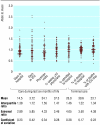Use of hospitals, physician visits, and hospice care during last six months of life among cohorts loyal to highly respected hospitals in the United States
- PMID: 15016692
- PMCID: PMC381130
- DOI: 10.1136/bmj.328.7440.607
Use of hospitals, physician visits, and hospice care during last six months of life among cohorts loyal to highly respected hospitals in the United States
Abstract
Objective: To evaluate the use of healthcare resources during the last six months of life among patients of US hospitals with strong reputations for high quality care in managing chronic illness.
Design: Retrospective cohort study based on claims data from the US Medicare programme.
Participants: Cohorts receiving most of their hospital care from 77 hospitals that appeared on the 2001 US News and World Report "best hospitals" list for heart and pulmonary disease, cancer, and geriatric services.
Main outcome measures: Use of healthcare resources in the last six months of life: number of days spent in hospital and in intensive care units; number of physician visits; percentage of patients seeing 10 or more physicians; percentage enrolled in hospice. Terminal care: percentage of deaths occurring in hospital; percentage of deaths occurring in association with a stay in an intensive care unit.
Results: Extensive variation in each measure existed among the 77 hospital cohorts. Days in hospital per decedent ranged from 9.4 to 27.1 (interquartile range 11.6-16.1); days in intensive care units ranged from 1.6 to 9.5 (2.6-4.5); number of physician visits ranged from 17.6 to 76.2 (25.5-39.5); percentage of patients seeing 10 or more physicians ranged from 16.9% to 58.5% (29.4-43.4%); and hospice enrollment ranged from 10.8% to 43.8% (22.0-32.0%). The percentage of deaths occurring in hospital ranged from 15.9% to 55.6% (35.4-43.1%), and the percentage of deaths associated with a stay in intensive care ranged from 8.4% to 36.8% (20.2-27.1%).
Conclusion: Striking variation exists in the utilisation of end of life care among US medical centres with strong national reputations for clinical care.
Figures
Comment in
-
Getting a grip on clinical variations in hospital services.BMJ. 2004 Mar 13;328(7440):610. doi: 10.1136/bmj.328.7440.610. BMJ. 2004. PMID: 15016693 Free PMC article. No abstract available.
-
Use of healthcare resources in the last six months of life: findings should be approached with caution outside United States.BMJ. 2004 May 15;328(7449):1201; author reply 1202. doi: 10.1136/bmj.328.7449.1201-b. BMJ. 2004. PMID: 15142938 Free PMC article. No abstract available.
-
Use of healthcare resources in the last six months of life: paper contains absolutely gorgeous and diverting sentence.BMJ. 2004 May 15;328(7449):1201-2; author reply 1202. doi: 10.1136/bmj.328.7449.1201-c. BMJ. 2004. PMID: 15142939 Free PMC article. No abstract available.
-
Use of healthcare resources in the last six months of life: how doctors learn may explain results.BMJ. 2004 May 15;328(7449):1202; author reply 1202. doi: 10.1136/bmj.328.7449.1202. BMJ. 2004. PMID: 15142940 Free PMC article. No abstract available.
Similar articles
-
Family Perspectives on Aggressive Cancer Care Near the End of Life.JAMA. 2016 Jan 19;315(3):284-92. doi: 10.1001/jama.2015.18604. JAMA. 2016. PMID: 26784776 Free PMC article.
-
Change in end-of-life care for Medicare beneficiaries: site of death, place of care, and health care transitions in 2000, 2005, and 2009.JAMA. 2013 Feb 6;309(5):470-7. doi: 10.1001/jama.2012.207624. JAMA. 2013. PMID: 23385273 Free PMC article.
-
Transitions Between Healthcare Settings of Hospice Enrollees at the End of Life.J Am Geriatr Soc. 2016 Feb;64(2):314-22. doi: 10.1111/jgs.13939. J Am Geriatr Soc. 2016. PMID: 26889841 Free PMC article.
-
Association Between Hospice Length of Stay, Health Care Utilization, and Medicare Costs at the End of Life Among Patients Who Received Maintenance Hemodialysis.JAMA Intern Med. 2018 Jun 1;178(6):792-799. doi: 10.1001/jamainternmed.2018.0256. JAMA Intern Med. 2018. PMID: 29710217 Free PMC article.
-
Determinants of hospice utilization among terminally ill geriatric patients.Home Health Care Serv Q. 1991;12(4):81-112. doi: 10.1300/j027v12n04_07. Home Health Care Serv Q. 1991. PMID: 10117496 Review.
Cited by
-
Hospital variation and temporal trends in palliative and end-of-life care in the ICU.Crit Care Med. 2013 Jun;41(6):1405-11. doi: 10.1097/CCM.0b013e318287f289. Crit Care Med. 2013. PMID: 23518869 Free PMC article.
-
Predictors of use of health care services among elderly lung cancer patients: the first year after diagnosis.Support Care Cancer. 2006 Mar;14(3):243-50. doi: 10.1007/s00520-005-0877-5. Epub 2005 Aug 13. Support Care Cancer. 2006. PMID: 16133070
-
Getting a grip on clinical variations in hospital services.BMJ. 2004 Mar 13;328(7440):610. doi: 10.1136/bmj.328.7440.610. BMJ. 2004. PMID: 15016693 Free PMC article. No abstract available.
-
Identification of hospital catchment areas using clustering: an example from the NHS.Health Serv Res. 2010 Apr;45(2):497-513. doi: 10.1111/j.1475-6773.2009.01069.x. Epub 2009 Dec 30. Health Serv Res. 2010. PMID: 20050933 Free PMC article.
-
Primary Palliative Care for Emergency Medicine (PRIM-ER): Protocol for a Pragmatic, Cluster-Randomised, Stepped Wedge Design to Test the Effectiveness of Primary Palliative Care Education, Training and Technical Support for Emergency Medicine.BMJ Open. 2019 Jul 27;9(7):e030099. doi: 10.1136/bmjopen-2019-030099. BMJ Open. 2019. PMID: 31352424 Free PMC article.
References
-
- Wennberg JE, Cooper MM, eds. The quality of medical care in the United States: a report on the Medicare program. The Dartmouth atlas of health care 1999. Chicago, IL: American Hospital Association Press, 1999. - PubMed
-
- Wennberg JE, Freeman JL, Culp WJ. Are hospital services rationed in New Haven or over-utilized in Boston? Lancet 1987;i: 1185-8. - PubMed
-
- Wennberg JE, Freeman JL, Shelton RM, Bubolz TA. Hospital use and mortality among Medicare beneficiaries in Boston and New Haven. N Engl J Med 1989;321: 1168-73. - PubMed
-
- Fisher ES, Wennberg JE, Stukel TA, Sharp SM. Hospital readmission rates for cohorts of Medicare beneficiaries in Boston and New Haven. N Engl Med 1994;331: 989-95. - PubMed
-
- Wennberg JE, Fisher ES, Skinner JS. Geography and the debate over Medicare reform. 2002. http://content.healthaffairs.org/cgi/content/full/hlthaff.w2.96v1/DC1 (accessed 4 Mar 2004). - PubMed
Publication types
MeSH terms
Grants and funding
LinkOut - more resources
Full Text Sources

